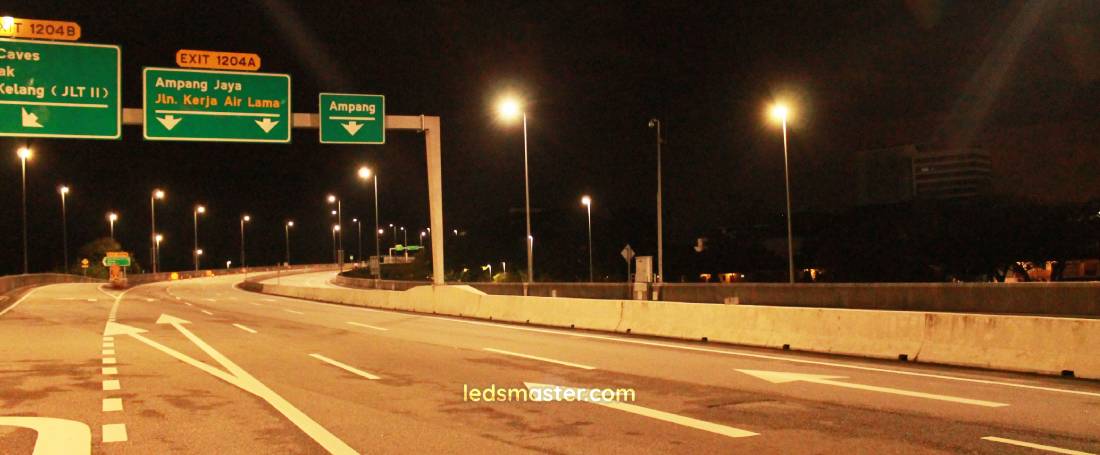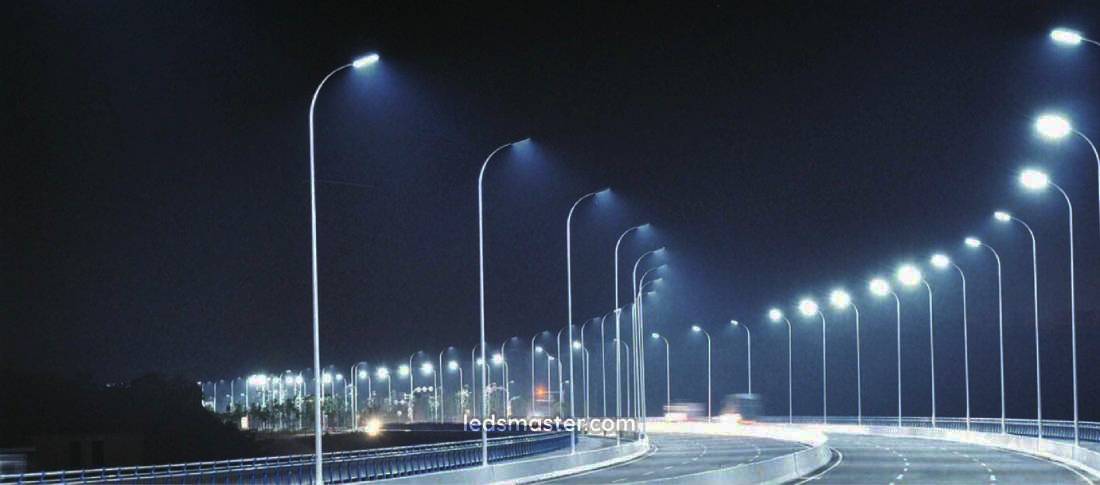Illuminate your highways with our cutting-edge highway lighting solutions. Designed for optimal visibility and safety, our lights ensure clear, reliable illumination, reducing accidents and enhancing the driving experience. Durable, energy-efficient, and easy to maintain, our highway lighting is the perfect choice for modern infrastructure needs.
Enhance highway safety and visibility with our state-of-the-art highway lighting solutions, offering optimal illumination levels between 100-150 lux for clear, uniform lighting. Engineered for durability and energy efficiency, our lights provide consistent performance and easy maintenance, making them the ideal choice for modern infrastructure. Ensure safer, well-lit roads with our premium highway lighting.
Get your complimentary lighting design today
Table of Contents
ToggleHighway lighting plays a vital role in enhancing the safety and efficiency of roadways, providing illumination that is necessary for both drivers and pedestrians. This comprehensive overview examines the various aspects of highway lighting, including appropriate lux levels, uniformity, the calculation of light quantities, and the implications of light pollution. Understanding these elements contributes to better highway design and a safer driving experience for everyone on the road.
The primary objective of highway lighting is to provide sufficient illumination to enhance visibility, enabling drivers to identify road signs, obstacles, and other vehicles effectively. Adequate lighting fosters a sense of security for road users, significantly improving overall safety.

Highway lighting systems are designed to address several challenges, including the need for consistent visibility and the ability to adapt to various environmental factors. Properly designed lighting contributes to reducing accidents, improving traffic flow, and enhancing the comfort of drivers and passengers alike.
The lux level, a measurement of light intensity, is a foundational consideration in highway lighting design. For highways, the recommended lux level typically ranges from 20 to 30 lux. This illumination level is sufficient to ensure that drivers can see and react to their environment appropriately, identifying road signs and potential hazards from a safe distance. By maintaining appropriate lux levels, highway lighting systems can effectively minimize driver reaction times and reduce the likelihood of accidents.
Insufficient lighting can significantly impair visibility, particularly in high-speed zones where quick reactions are critical. When roads are inadequately illuminated, drivers may struggle to perceive oncoming vehicles, pedestrians, or obstacles, increasing the chances of accidents.
Conversely, excessive lighting can produce glare, which can also be hazardous, impairing driver vision and contributing to unsafe driving conditions. Glare occurs when the brightness of a light source exceeds the ability of the eye to adapt, creating discomfort and temporary blindness. This phenomenon is particularly problematic in urban environments where streetlights may compete with illuminated billboards and building signage, leading to visual overload for drivers.
Modern lighting technologies, particularly LED systems, have gained popularity in highway lighting due to their ability to provide consistent illumination while being energy-efficient. LED lights offer longer lifespans and lower energy consumption compared to traditional incandescent and fluorescent lights. Additionally, the directional nature of LED lighting minimizes light pollution, focusing illumination where it is most needed.
Uniformity in highway lighting refers to the consistent distribution of light across the entire roadway. Ensuring high uniformity levels is vital for minimizing dark spots and overly bright areas along the road. Sudden changes in light intensity can disorient drivers, causing temporary blindness or confusion, which can lead to accidents. Therefore, achieving uniform lighting is an integral aspect of highway design, contributing to a smoother and safer driving experience.
To achieve uniformity, careful planning and strategic placement of light fixtures are essential. Several factors come into play, including the spacing between lights, the height of light poles, and the type of fixtures used.

Advanced lighting designs often incorporate LED technology, which offers superior directional control. This control allows for precise adjustments to ensure high levels of uniformity throughout the illuminated area.
Moreover, employing computer simulations and photometric analyses during the design phase can significantly enhance uniformity. These tools help optimize the placement and intensity of lights, ensuring that the entire road is evenly lit. Such analyses take into account the geometry of the road, existing light sources, and the specific lighting requirements for each section of the highway.
Calculating the number of lights necessary for effective highway illumination is a multifaceted process that considers various factors. Key variables include the length and width of the highway, traffic density, and environmental conditions. Proper assessment and strategic placement of lights are paramount to achieving consistent illumination while adhering to the recommended lux levels.
During the design phase, a detailed lighting plan is developed. This plan includes a comprehensive photometric analysis that evaluates the road’s geometry, existing light sources, and specific lighting requirements.
The goal is to ensure uniform and adequate lighting while minimizing the number of fixtures to reduce energy consumption and maintenance costs. Excessive lighting can lead to increased operational costs and environmental concerns, making it imperative to strike a balance between illumination and efficiency.
Factors such as pole height and fixture type also play a significant role in determining the number of lights needed. By adjusting these parameters, lighting designers can optimize light distribution and coverage, ensuring that the illumination is both effective and efficient.
While highway lighting serves a vital function in enhancing safety, it can also contribute to light pollution if not managed correctly. Light pollution refers to excessive, misdirected, or obtrusive artificial light that disrupts natural ecosystems and affects human health. Various forms of light pollution, such as skyglow, glare, light trespass, and light clutter, can result from poorly designed highway lighting systems.
Skyglow occurs when artificial lighting brightens the night sky over populated areas, making it challenging to view stars and celestial bodies. This phenomenon is often exacerbated by inadequately designed highway lighting.
Glare, caused by overly bright or poorly shielded lights, can impair the vision of drivers and pedestrians, increasing the risk of accidents. When drivers encounter glare, their ability to see the road ahead can be compromised, leading to potentially dangerous situations. To combat glare, it is essential to use appropriately designed fixtures and to position them correctly to minimize direct exposure to oncoming traffic.
Light trespass happens when unwanted light spills over into adjacent areas, negatively impacting homes, wildlife, and vegetation.
Light clutter, characterized by an excessive grouping of lights, can create confusion and visual discomfort for drivers. In areas with numerous light sources, it becomes challenging for drivers to discern important visual cues, leading to potential hazards. Reducing light clutter involves strategic planning to limit the number of fixtures while ensuring sufficient illumination.
To mitigate the impact of light pollution, highway lighting systems should be designed with features that minimize light spill and glare. Full-cutoff fixtures, which direct light downward, are particularly effective in preventing light from spreading horizontally or upward. These fixtures help ensure that the light illuminates the roadway without causing unnecessary glare or light trespass into surrounding areas.
Adaptive lighting systems offer another solution to reduce light pollution. These systems can adjust light intensity based on traffic volume and weather conditions, ensuring that unnecessary illumination is minimized.
The choice of light color is another factor in mitigating light pollution. Warm-colored lights, as opposed to cool, blue-rich lights, can reduce the impact on nocturnal wildlife and human circadian rhythms. Warm lighting tends to be less disruptive to the natural environment and may help maintain a healthier balance between artificial and natural light.
Incorporating input from environmental experts during the design phase can lead to solutions that effectively address light pollution concerns. By considering the ecological impacts of lighting, designers can develop strategies that not only meet safety requirements but also protect local wildlife and ecosystems.
Advancements in technology continue to influence the design and implementation of highway lighting systems. Smart lighting solutions, which integrate sensors and real-time data, can enhance safety and efficiency.
These systems can detect traffic patterns, adjust illumination levels, and even communicate with connected vehicles to improve overall roadway safety.
Additionally, innovations in lighting control systems allow for better management of illumination. These systems can be programmed to respond to specific conditions, such as increased traffic or inclement weather, ensuring that highway lighting remains effective and responsive to changing needs.
Highway lighting is an integral aspect of modern transportation infrastructure that significantly contributes to road safety and driver comfort. The design and implementation of effective highway lighting systems hinge on several factors, including appropriate lux levels, uniformity, the calculation of light quantities, and measures to mitigate light pollution.
As advancements in technology continue to evolve, the future of highway lighting holds great promise. Ongoing innovation in lighting design and implementation will further enhance the safety and sustainability of our roadways, paving the way for a brighter and safer future for all road users.
With thoughtful design and an emphasis on sustainability, highway lighting can play a transformative role in enhancing the safety and efficiency of our transportation networks.